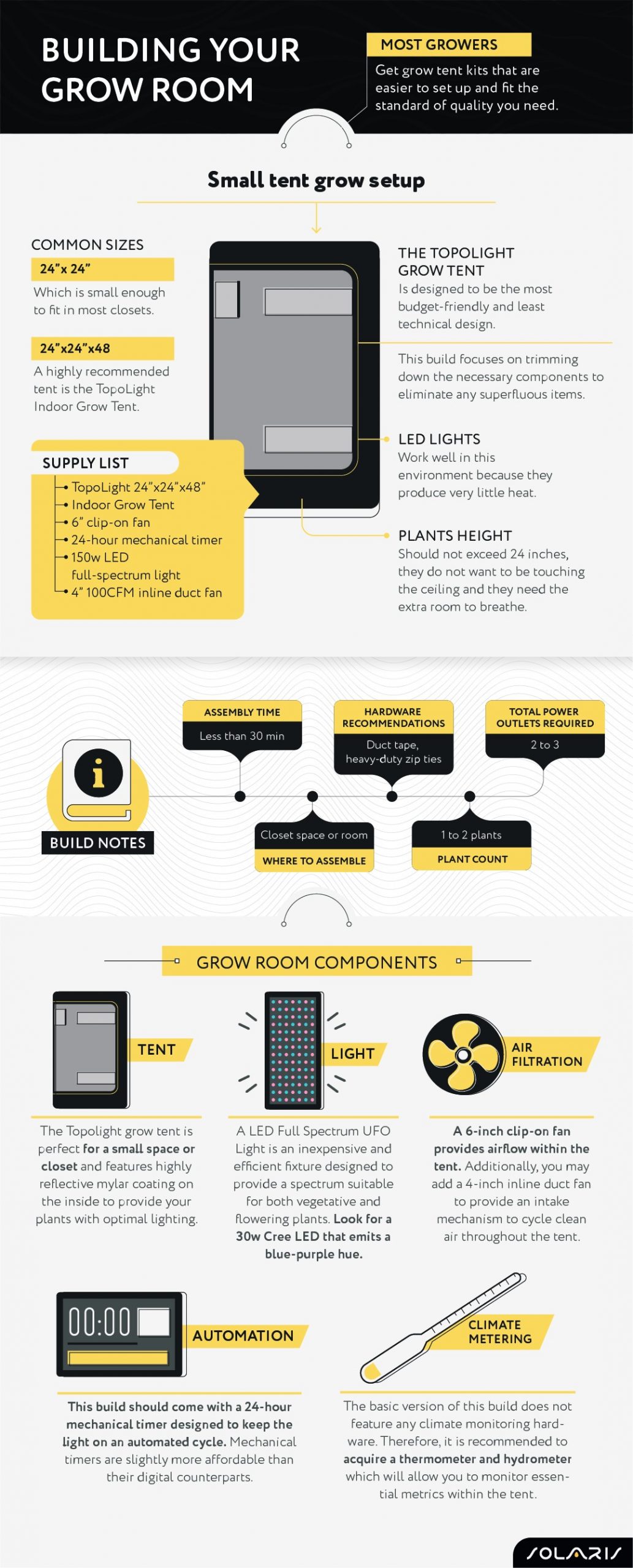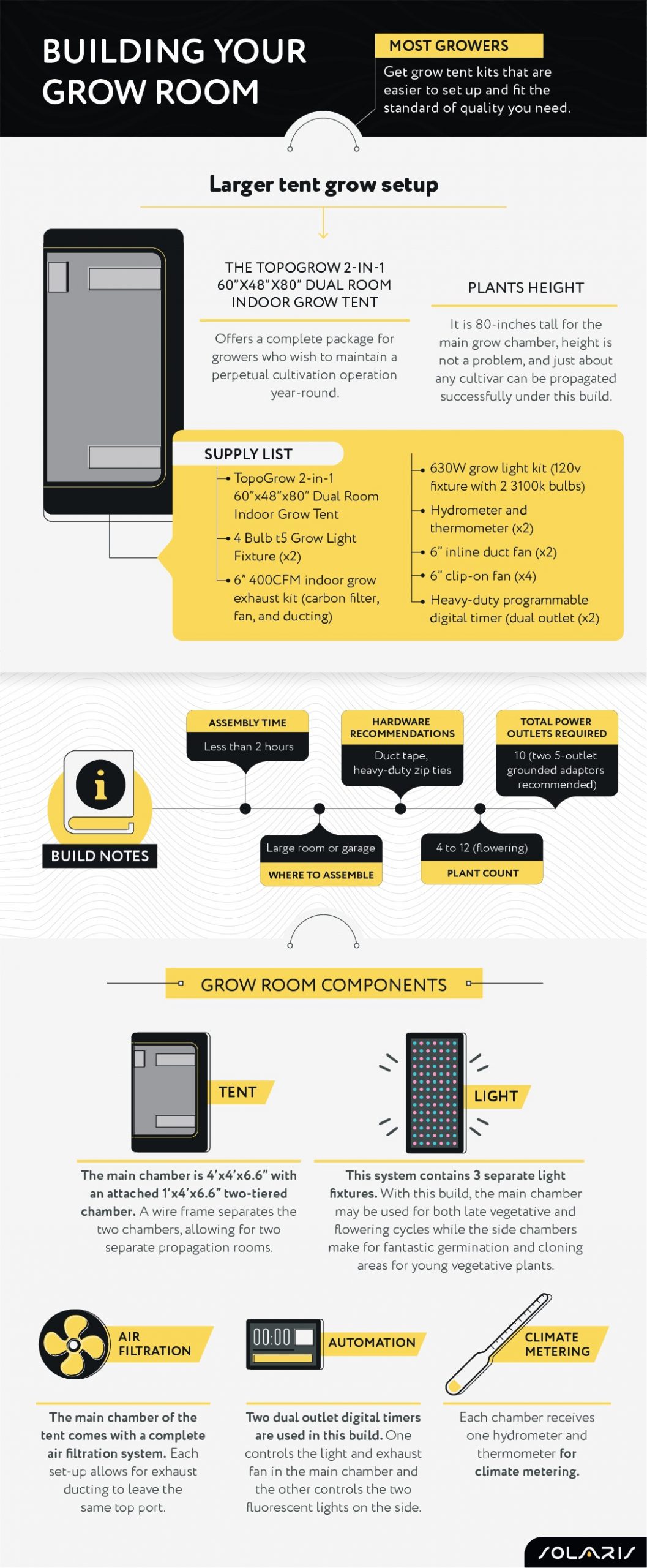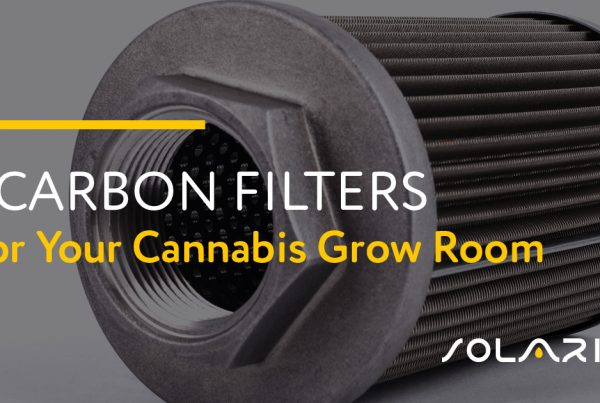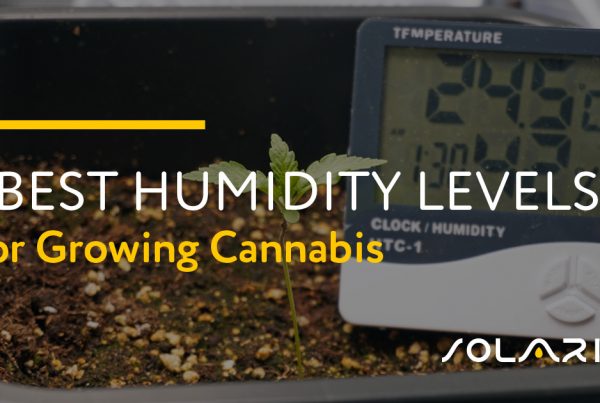If you have decided to grow medical cannabis indoors rather than outside in the garden, you will need to set up a space dedicated to tending your cannabis plants. There are many ways to prepare a grow room; in fact, space does not even need to be an actual room.
You will need to know how many plants you want to grow, what types of growing mediums you plan on using, the lighting that will be utilized, and how to supply the electrical needs to the growing space. Having a well-thought-out plan will save you money and time.
Whether starting with a single grow tent, a stealthy grow box, or a full-scale commercial grow room, how you set up your growing space goes a long way in determining your final yields.
How much space do I need for my grow room?
Chances are you will want to make sure your grow room has space for more than just the plants sprung from your cannabis seeds. A 2×2 foot area can hypothetically hold 16 plants, but you will be unable to maneuver between them or store other supplies in the same space. Furthermore, a small area leads to more chance of mold developing on the leaves of the plants as they grow and begin overlapping one another.
If you are planning to use just one section of a room as your grow room, set up a designated area that is completely light-proof and sealed. You can build a wooden frame, a floor-to-ceiling contraption, or even purchase a grow tent, depending on your handiness and budget.
For a cupboard or closet grow room your tools will have to be kept elsewhere. The primary thing to remember when using a smaller space you did not create from scratch, is that you will need space for essential equipment as well; lights, humidifier, vents, etc. You will also have to plan for various tubes and wires coming out of the enclosed area.
Do not forget your cannabis plants will not always be little seedlings barely an inch tall. They are going to grow at least a foot, and considerably more in many cases, and the branches and leaves will grow horizontally past the sides of the pots. Keep these future space requirements in mind when planning your grow room size.
Light proofing
An entirely light-proof grow room is absolutely necessary. Light leakage can be annoying depending on the location of your grow because grow lights are extremely bright. Light leakage can keep you awake at night if your grow room is a bedroom cupboard or set up in a spare corner of a room. It could also advertise to your whole neighborhood that you are growing weed if it leaks out of a window.
Most importantly, light leakage into the grow room can adversely affect plant performance. Once plants have been flipped to the 12-12 lights on and off cycle to induce flowering, light leakage can confuse plants and lead to a lower yield, hermaphroditism, or even failed crops due to light stress.
Once your grow space is set up, do a test by turning on the lights and inspecting for any light leakage. Any cracks or holes that let light out will certainly let light in. If leaks are discovered, patch the holes with light-proof tape available at hardware stores or with at least two layers of gaffer tape (gaffer tape is semi-translucent).
Most electrical equipment kept in a grow room, such as dehumidifiers, have bright micro-LED lights, which can do the same plant damage as environmental light leakage. Place a piece of tape over any lights on these types of appliances to ensure nights are as dark as possible.
Outdoors, the subdued light of the full moon has beneficial effects on plant growth, but this effect is difficult to translate to an indoor grow.
Climate control
Cannabis thrives when the climate is controlled regarding air, humidity, and temperature, with certain parameters ideal for vegetation and other parameters ideal for the flowering stage. Your grow room needs to be sealed off as much as possible for you to control the climate of your plants. A stable environment is very important for optimum plant performance.
Temperature and humidity
A cannabis grow room should remain around 80 degrees Fahrenheit. Temperatures can be controlled with small, portable, reverse cycle air-conditioning (AC) units.
Unfortunately, air conditioners tend to dry out the air. To counteract this, and keep the grow room humidity around 75 percent, you will want to install a humidifier large enough to affect the entire space. Ideally, choose one with a hygrostat so the humidity level will be automatically adjusted. Automating the whole thing makes growing life a lot easier.
You also need to be prepared if there is too much humidity by having a dehumidifier; these are also available as double-action units that will add or subtract humidity as necessary. During vegetation, a humid and warm environment increases the rate of growth, while lower humidity and temperatures increase bud development during the flowering stage.
Airtight seal
As your cannabis plant matures into resinous, fat buds, strong smells will begin to fill the space. Some weed can stink up a whole house, or even a street. It is easy to grow used to that luscious aroma and become convinced that the smell is not going further than your grow room. A well-sealed grow room prevents aromas from disturbing neighbors or your roommates.
A sealed room also acts as a quarantine cell for your plants, preventing any bugs, vermin, or airborne pathogens from entering. A single mouse can do a lot of damage to cannabis in only one night, especially to young plants, as they are voracious for nutrient-dense leaves and young stalks.
It should be noted that an airtight grow room is also crucial for keeping your expenses in check. Spending more to set up an air exchange system will benefit your weed substantially and will pay itself back in the long run.
Air circulation
Cannabis needs fresh air to grow well. Once the carbon dioxide (CO2) in the air has been absorbed, and oxygen has been expelled, the used air needs to be removed from the grow room, and fresh air cycled in. Intake and outtake ventilation systems are required to handle this task.
During colder seasons, the clean air you are pumping into your grow room should be from another indoor space as opposed to from outside; that cold air can ruin the integrity of your carefully controlled environment.
Once the air has entered the grow room, it should be moved around by fans. These fans are not just useful for spreading the air, they also simulate outdoor breezes, which are important for strengthening the stems of the plants and keeping mold from growing. Moving air also helps with the wet-dry cycle of the growing medium by supporting evaporation.
The oxygenated air your cannabis plants give off must be quickly removed, and should be pumped straight outside. The smell of the plants will go with this air, so avoid pumping it into another room. You can place a carbon filter over the outtake vent to minimize the smell. A suction pump may be useful for removing the air from the grow room.
Safety and fire prevention
Although most growers make it to harvest time without any mishaps, numerous horror stories document how bad things can get when an accident happens. Having safety measures in place is an important action, especially if you plan to invest in a large-scale grow operation.
Electrical equipment
Although many cannabis growers like to keep their operation minimal, others like to use as many helpful gadgets as possible. But, even a small number of electronics in the grow space runs the risk of fire.
Water remains one of the biggest risks in the grow room when it comes to electronics. Water can interrupt an electrical current, potentially leading to a fire or electrocution. Try as hard as possible to keep electronics elevated above the ground in case of any water leaks.
Using a ground fault circuit interrupter (GFCI) will help to stop electrical leaks when they arise. This device detects when electricity flows where it should not and breaks the circuit.
Upkeep
Keep your grow room as tidy as possible. Create a dedicated space for each piece of equipment, and keep wires running neatly using plastic zip ties. If you notice any damaged or exposed wires, repair them immediately.
Clear away all tools after using them to prevent any trip hazards. Keep your pruning shears, watering cans, and spray bottles packed away in a toolbox when not in use. Not only can tripping result in injury, but you might also land on your plants and cause some serious damage.
Fire extinguisher
Although rare, you should be entirely prepared for a fire to break out. Grow room fires can destroy your property, put your life at risk, and also expose your weed room to the authorities. Keep a fire extinguisher close by at all times in case your setup goes up in flames.
Install a fire alarm in your grow room to alert you if a fire breaks out. Purchase a handheld fire extinguisher and keep it at the entrance to your grow room or tent. Purchase a model that contains dry chemical powder or carbon dioxide suitable to tackle electrical fires.
Alternatively, purchase an extinguisher ball and position it above your growing space. Upon exposure to excess heat, these devices explode and release fire-retardant powder.
Building your grow room
Now that you have selected a space that satisfies the demands for a healthy and discreet grow, it is time to build your grow room. There are many solutions to create a grow room at home on a budget. You could go to a hardware store and get some wood and plastic to make one out of scratch.
However, most growers go the route of getting grow tent kits that are easier to set up and fit the standard of quality you need. There are a range of sizes with these tents, from small to large.
Small tent grow setup

First-time growers, budget growers, and those who wish to keep their garden as inconspicuous as possible are a good fit for small grow tents, as it is a basic grow setup. These tents commonly size out at 24”x 24” which is small enough to fit in most closets. A highly recommended tent is the TopoLight 24”x24”x48” Indoor Grow Tent.
Supply list:
- TopoLight 24”x24”x48” Indoor Grow Tent
- 6” clip-on fan (check your options here)
- 24-hour mechanical timer
- 150w LED full-spectrum light
- 4” 100CFM inline duct fan (optional)
- Hydrometer and thermometer
The TopoLight grow tent is designed to be the most budget-friendly and least technical design. This build focuses on trimming down the necessary components to eliminate any superfluous items.
LED lights work well in this environment because they produce very little heat. Although filtration for a grow of this size is not necessary, those who wish to grow in a more confined space should consider opting for the intake fan. This will help to increase air circulation for the plants.
With the tent height maxing out at 48 inches, plants grown in this space should not exceed 24 inches in height. Plants do not want to be touching the ceiling and they need the extra room to breathe. To abide by these height restrictions, it may be best to grow indica and auto-flowering varieties which tend to stay shorter than sativa plants.
Build notes:
- Assembly time: less than 30 min
- Hardware recommendations: Duct tape, heavy-duty zip ties
- Total power outlets required: 2 to 3
- Where to assemble: Closet space or room
- Recommended plant count: 1 to 2 plants
Grow room components:
- Tent: The Topolight grow tent is perfect for a small space or closet and features highly reflective mylar coating on the inside to help provide your plants with optimal lighting.
- Light: A LED Full Spectrum UFO Light is an inexpensive and efficient fixture designed to provide a spectrum suitable for both vegetative and flowering plants. Look for a 30w Cree LED that emits a blue-purple hue. Make sure to acquire the necessary components to hang the light at variable heights to follow the cannabis canopy as it grows.
- Air filtration: A 6-inch clip-on fan provides airflow within the tent. Additionally, you may add a 4-inch inline duct fan to provide an intake mechanism to cycle clean air throughout the tent. If you decide to get the intake duct fan, install it on the bottom of the tent using duct tape and zip ties. The clip-on fan will help move air around inside the tent. By keeping the top duct port open, air may exhaust passively. If you decide to opt-out of the intake duct fan, leave both the bottom and the top port open for air movement.
- Automation: This build should come with a 24-hour mechanical timer designed to keep the light on an automated cycle. Mechanical timers are slightly more affordable than their digital counterparts.
- Climate metering: The basic version of this build does not feature any climate monitoring hardware. Therefore, it is recommended to acquire a thermometer and hydrometer which will allow you to monitor essential metrics within the tent.
Larger tent grow setup

The TopoGrow 2-in-1 60”x48”x80” Dual Room Indoor Grow Tent offers a complete package for growers who wish to maintain a perpetual cultivation operation year-round. It covers all of the essentials in housing, lighting, automation, and filtration for a standard home grow.
No matter what your legal plant limit is, this tent should be able to handle it. At 80-inches tall for the main grow chamber, height is not a problem, and just about any cultivar can be propagated successfully under this build.
For growers who want a full system capable of germinating seedlings, taking and keeping clones, maintaining mother plants, and have multiple chambers for various projects, this is the build for you. However, this system tends to run hot and will need the open air of a large room or garage to function optimally.
Supply list:
- TopoGrow 2-in-1 60”x48”x80” Dual Room Indoor Grow Tent
- 4 Bulb t5 Grow Light Fixture (x2)
- 6” 400CFM indoor grow exhaust kit (carbon filter, fan, and ducting)
- 630W grow light kit (120v fixture with 2 3100k bulbs)
- Hydrometer and thermometer (x2)
- 6” inline duct fan (x2)
- 6” clip-on fan (x4)
- Heavy-duty programmable digital timer (dual outlet (x2))
The TopoGrow 2-in-1 60”x48”x80” Dual Room Indoor Grow Tent is designed to be a fully comprehensive cannabis cultivation and propagation system, offering an all-inclusive perpetual grow space packed into a 4×5-foot build. You get a 3-chambered, 3-light tent with a full air filtration system, automation and metering included.
This build allows growers to cultivate at multiple stages in the plant’s life cycle as well as provide housing for multiple propagation projects.
The 4×4-foot main tent is powered by a 630w CMH light and the 1×4-foot two-tiered tent extension is built out with two 4-bulb t5 fluorescent light fixtures. Complete with four fans, two dual outlet timers, and adjustable intake/exhaust components, this 80-inch tent supports even the most ambitious of grows.
Build notes:
- Assembly time: less than 2 hours
- Hardware recommendations: Duct tape, heavy-duty zip ties
- Total power outlets required: 10 (two 5-outlet grounded adaptors recommended)
- Where to assemble: Large room or garage
- Recommended plant count: 4 to 12 (flowering)
Grow room components:
- Tent: The main chamber is 4’x4’x6.6” with an attached 1’x4’x6.6” two-tiered chamber. A wire frame separates the two chambers, allowing for two separate propagation rooms. The main and second chambers of the tent are divided by a velcro-applied detachable, double-ended mylar fabric barrier.
- Light: This system contains 3 separate light fixtures. The main room is outfitted with a 120v 630w CMH fixture with double 3100k bulbs, while the two-tiered chamber contains a pair of 12”x48” t5 fluorescent light bulb fixtures (4-bulb) stacked vertically. With this build, the main chamber may be used for both late vegetative and flowering cycles while the side chambers make for fantastic germination and cloning areas for young vegetative plants.
- Air filtration: The main chamber of the tent comes with a complete air filtration system. The intake is one 6-inch inline duct booster fan fastened at the bottom of the tent. A second 6-inch booster fan removes hot air from the top of the tent and sits just left of the CMH fixture. For exhaust, a 400CFM kit should be used. The kit should contain a 6-inch carbon filter, heavy-duty duct exhaust fan (with a speed controller), as well as 6-inch aluminum ducting. This system may either be fastened to the top back end of the tent via heavy-duty zip ties and duct tape or placed on the ground in the back right corner of the tent. Each set-up allows for exhaust ducting to leave the same top port. The main room receives two 6-inch clip-on fans, one set up to canopy height and the second fastened to a top support beam directing air towards the light fixture and a 6-inch exhaust fan. The two-tiered side chamber gets a 6-inch clip-on fan for each room.
- Automation: Two dual outlet digital timers are used in this build. One controls the light and exhaust fan in the main chamber and the other controls the two fluorescent lights on the side.
- Climate metering: Each chamber receives one hydrometer and thermometer for climate metering.


